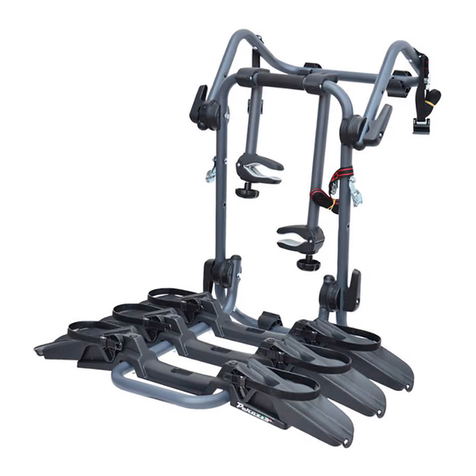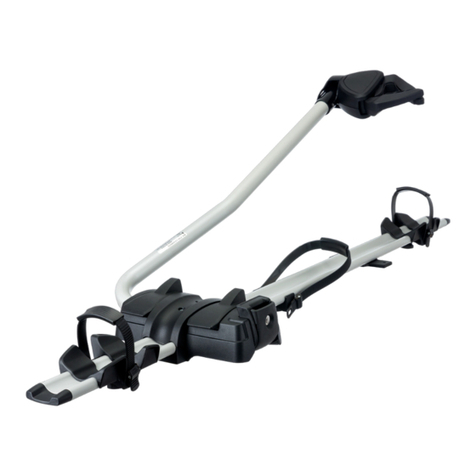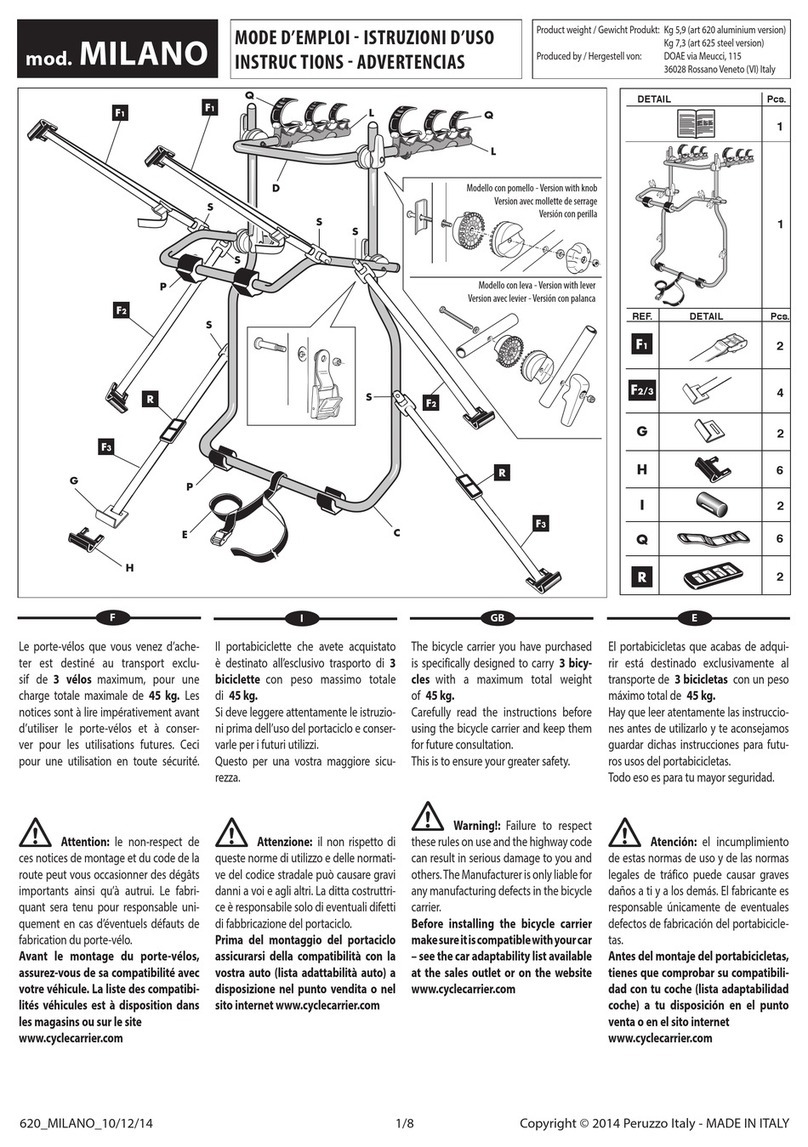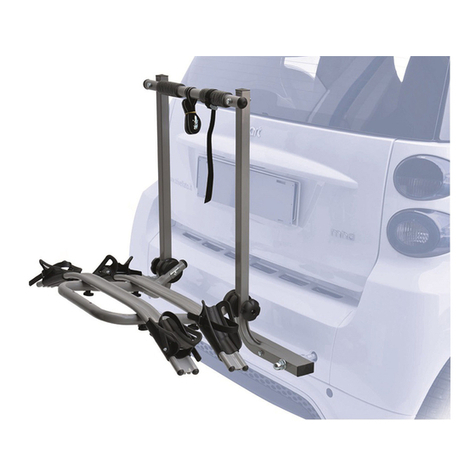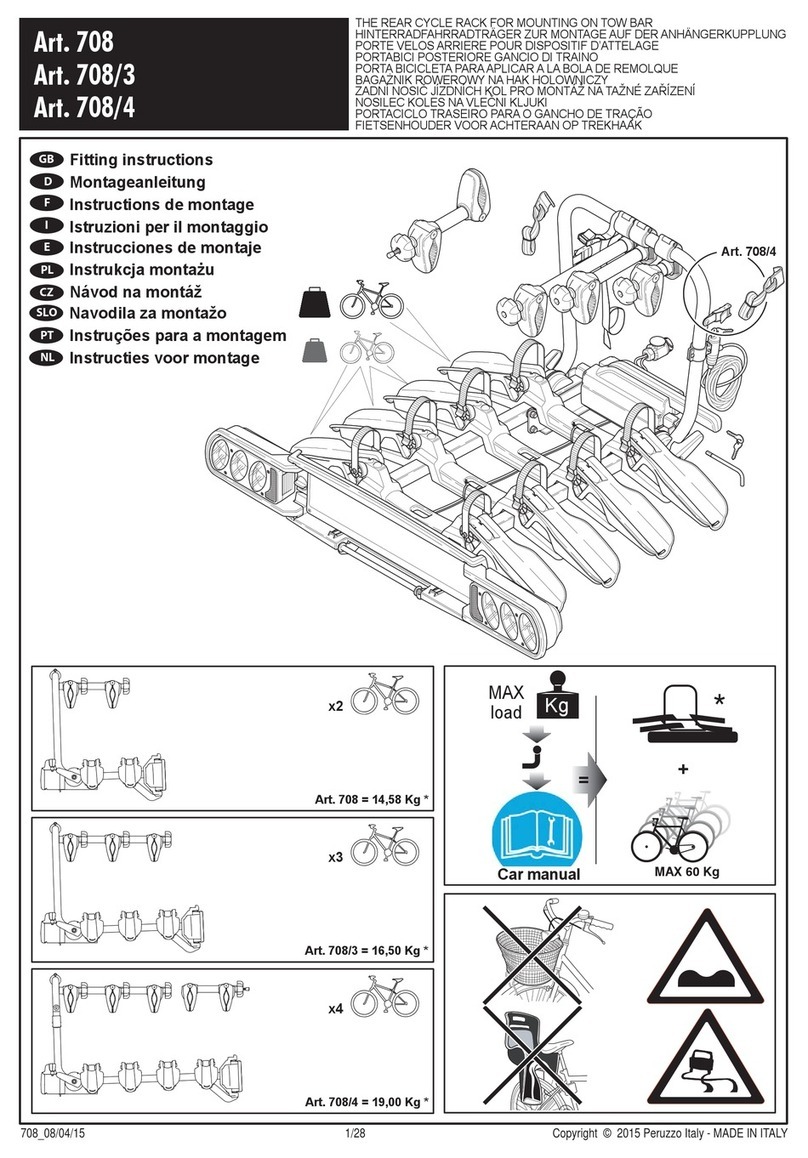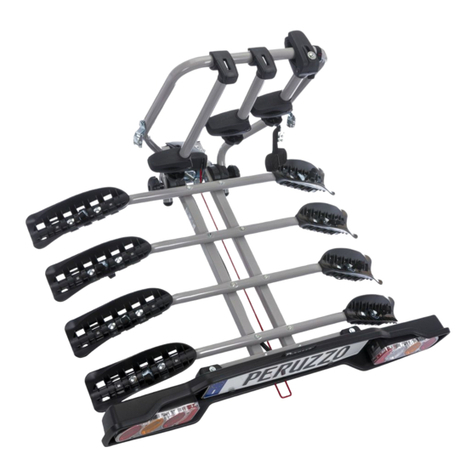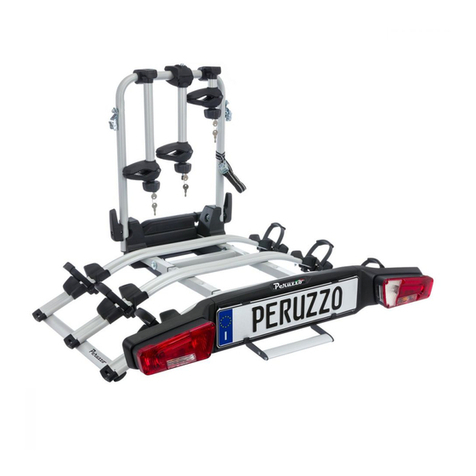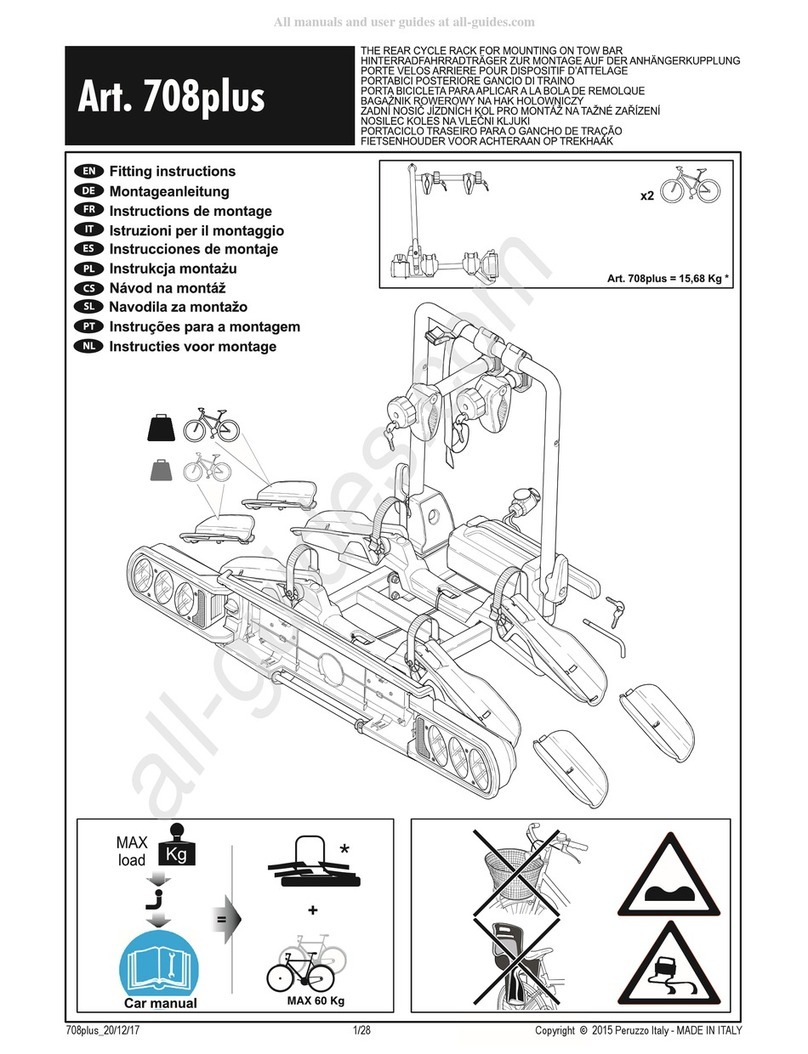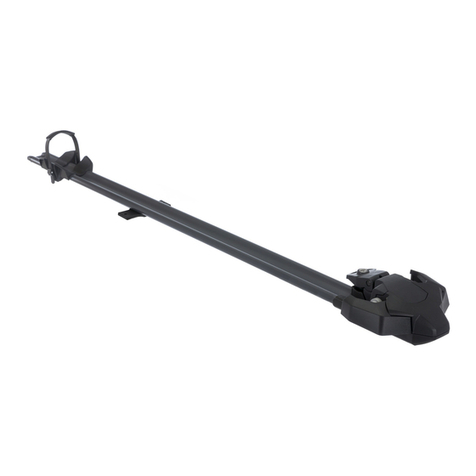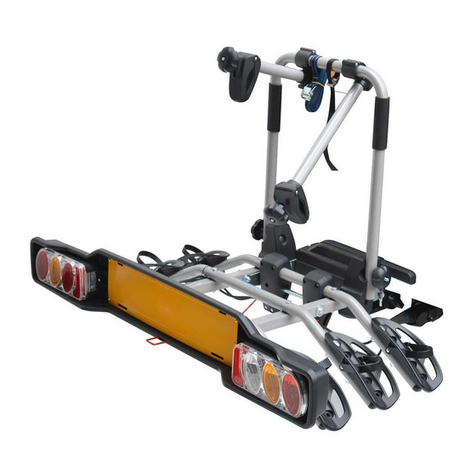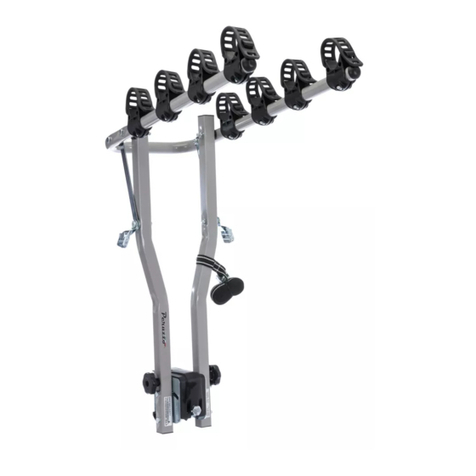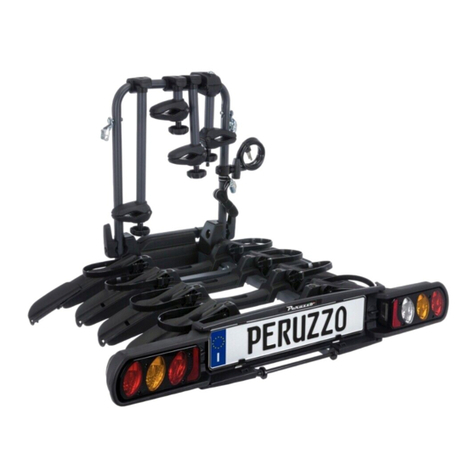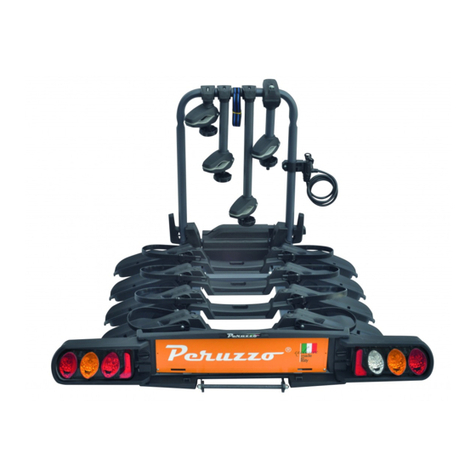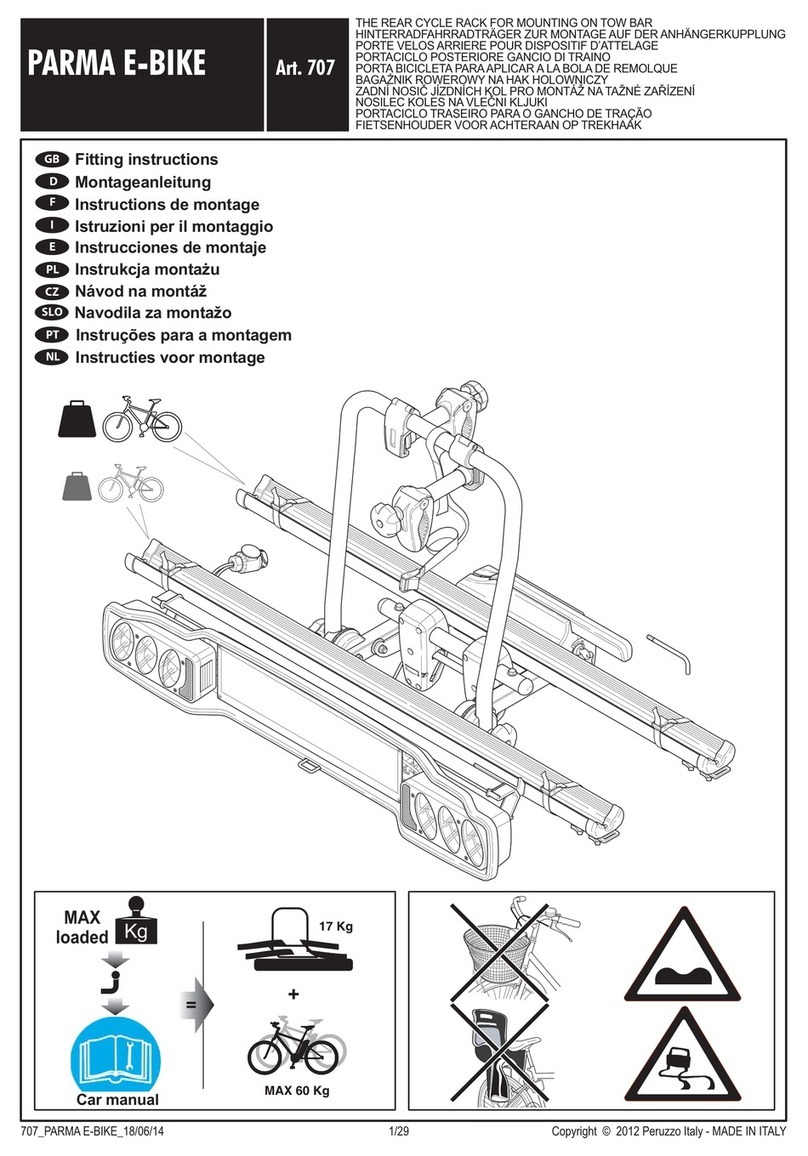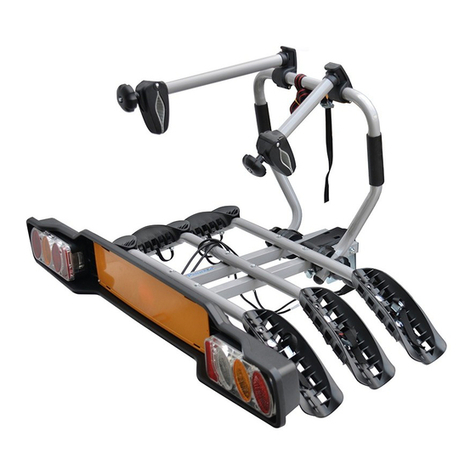
Copyright © 2016 Peruzzo Italy - MADE IN ITALY9/12
709_29/09/16
E GB D
SUJECIÓN DE LAS BICICLETAS
1. Coloque en el portabicicletas la bicicleta más
grande y pesada, poniendo las ruedas en los
apoyos correspondientes K y apoyando la bici-
cleta en el arco de fijación Z . Fije la bicicleta
con la correa de fijación Q al arco de fijación Z .
Sujete las ruedas con las correas de fijación W .
ATENCIÓN: en caso de que sean cargadas bicicle-
tas E-bike, retirar la batería .
Si la bicicleta sobresale excesivamente de los apoyarrue-
das, utilice los dos adaptadores en U incluidos (fig. );
están disponibles otros adaptadores opcionales (art. 985).
ATENCIÓN: las correas que sujetan las ruedas sir-
ven exclusivamente para mantener las bicicletas en
la posición correcta durante el viaje.
2. Repita las operaciones del punto 1 para la segunda y la
tercera bicicleta. Si se deben colocar 2 o 3 bicicletas, hága-
lo en forma alternada, según el esquema . En caso de
dificultades durante su colocación, evalúe la posibilidad
de inclinar los manillares. La segunda y la tercera bicicleta
se deben colocar en el arco de fijación Z mediante los bra-
zos de fijación M yL . Utilice la correa E para bloquear
correctamente las bicicletas en el portabicicletas, .
3. Bloquee los manillares, las ruedas y los pedales para evitar
movimientos improvisos; durante estos ajustes, pres-
te atención para no dañar la pintura del automóvil.
4. ATENCIÓN: Ninguna parte de la bicicleta en
particular, el pedal y el manubrio debe estar en
contacto con la carrocería o el vidrio trasero del
automóvil.
5. Verifique que las gomas de las bicicletas no queden
cerca del tubo de escape.
IMPORTANTES INFORMACIONES
PARA LA SEGURIDAD
1. Para un uso seguro, es indispensable fijar con
fuerza las bicicletas al portabicicletas. Si la
correa E no se utiliza correctamente, las bicicletas
no están bien sujetas y se pueden desprender del
portabicicletas, con graves consecuencias.
1. El peso de las bicicletas puede provocar pérdida
de tensión de las correas inferiores; por lo tanto,
es necesario controlarlas y, si es necesario, ten-
sarlas .
CONDUCCIÓN DEL VEHÍCULO CON EL
PORTABICICLETAS
1. Lea atentamente en su totalidad el presente manual
de instrucciones.
2. Utilice el portabicicletas solo para transportar bici-
cletas (máx. 3 y peso máx. 45 kg, sin superar la
capacidad máxima del vehículo).
3. No utilice el portabicicletas sin las bicicletas.
4. Quite el portabicicletas cuando no se utiliza.
5. La carga debe ser distribuida correctamente en el
portabicicletas trasero, manteniendo el centro de
gravedad de la carga lo más bajo posible. Las cargas
que sobresalen de las extremidades del portabici-
cletas trasero deben cumplir con la reglamentación
vigente en el país de uso y deben ser adecuada-
mente fijadas. Verifique que los componentes de
la bicicleta (como el manubrio o los pedales) no
sobresalgan del perfil del vehículo. La fijación de
la carga y el ajuste de los elementos de fijación del
portabicicletas trasero deben ser verificados una
vez terminada la carga, después de un breve tra-
yecto y, a continuación, a intervalos periódicos, en
función de la superficie de la carretera, .
6. Utilice el producto solo si está en perfectas condi-
ciones (verifique el ajuste de los pernos, la solidez de
las correas, etc.; véase el capítulo “Mantenimiento”).
7. Es obligatorio que la matrícula y las luces trase-
26
27
25
27
28
29
29
30
30
FIXING THE BIKES
1. Place the biggest and heaviest bike on the bike rack,
position the wheels in the tire cradles K and lean the
bike up on the bike fixing arch Z . Secure the bike to
the bike fixing arch Z with the fixing strap Q . Secure
the wheels by means of the fixing straps W .
ATTENTION: when using an E-Bike with this product
the battery should ALWAYS be removed .
If your bike protrudes excessively from the wheel
cradles, use the 2 supplied U adapters (fig. ); fur-
ther adapters are available as optional extras art. 985.
ATTENTION: the straps that block the wheels are only for
keeping the bikes in the proper position when travelling.
2. Repeat the operations indicated in point 1 for the second
and third bike. When fitting 2 or 3 bicycles, alternate
them according to the diagram . In case of difficulty in
positioning them, appraise the possibility of tilting the
handlebars. The second and third bikes are secured to the
bike fixing arch Z with the fixing arms M and L , then use
the strap E to block the bikes correctly on the bike rack, .
3. Secure handlebars, wheels and pedals in order to
prevent unwanted movements; during these adjust-
ments take care not to damage the car’s paintwork.
4. ATTENTION: no part of the bicycle, and in particu-
lar the pedal and the handlebar, must be in contact
with the bodywork or rear window of the car.
5. Ensure that the wheels of the bicycles are not posi-
tioned near the exhaust pipe.
IMPORTANT INFORMATION
REGARDING SAFETY
1. For safe use, the bicycles must be tightly secured
to the bike rack. If the strap E is not correctly
used the bicycles are not securely fixed and can
come off the bike rack with serious consequences.
2. The weight of the bicycles can cause a slackening
in the bottom straps; therefore it is necessary to
check them, retightening if necessary.
DRIVING WITH THE BIKE CARRIER
1. Read this instruction manual carefully and com-
pletely.
2. Only use the bike carrier for transporting bicycles
(max 3, max weight 45 kg, and in any case no great-
er than the maximum capacity of the vehicle).
3. Do not use the bike carrier without bicycles.
4. Remove the bike carrier when not in use.
5. The load must be distributed correctly on the rear
bike carrier and the centre of gravity should be
kept as low as possible. Loads protruding from the
ends of the rear bike carrier must comply with the
provisions of the rules in force in the country of use
and must be fixed adequately. Ensure that parts of
the bicycle, such as the handlebar or pedals, do not
stick out beyond the sides of the vehicle. Fixing the
load and tightening the fasteners of the bike carrier
device must be checked after loading, after a short
trip and then at regular intervals depending on the
road surface travelled over, .
6. Use the product only if it is in perfect condition
(check the tightness of the bolts, the solidity of the
straps, etc.: see the maintenance chapter).
7. The rear numberplate and lights must compul-
sorily be visible: if they are not, use a supple-
mentary light repeater bar and numberplate
as shown in . See the car list. The lights
must be compliant with national regulations. The
26
27
25
27
28
29
29
30
30
31 32 33
BEFESTIGUNG DER FAHRRÄDER
1. Als erstes ist das größte und schwerste Fahrrad auf
dem Fahrradträger zu positionieren. Dabei die Räder
in die Radstütze K setzen und das Fahrrad an den
Befestigungsbügel Z legen. Das Fahrrad mit dem
Befestigungsriemen Q am Befestigungsbügel Z fixieren.
Die Räder mit den Befestigungsriemen W fixieren.
ACHTUNG: Sollten Sie E-Bikes laden bauen Sie zuvor
die Batterie aus .
Falls Ihr Fahrrad zu weit über die Radstütze hinausragt,
verwenden Sie bitte die beiden zum Lieferumfang
gehörenden U-Adapter(Abb. ). Weitere Adapter mit der
Artikelnummer 985 sind als Sonderzubehör erhältlich.
ACHTUNG: Die Riemen, mit denen die Räder
bewegungsunfähig gemacht werden, dienen
ausschließlich dazu, die Fahrräder während der Fahrt
in der richtigen Position zu halten.
2. Wiederholen Sie die Schritte des Punktes 1 für das zweite
und dritte Fahrrad. Werden 2 oder 3 Fahrräder angebracht,
müssen sie nach dem Schema abgewechselt werden. Falls
sie sich nur mit Mühe positionieren lassen, ziehen Sie bitte
die Möglichkeit in Betracht, die Lenkstangen umzulegen. Das
zweite und dritte Fahrrad wird mit den Befestigungsarmen M
und L am Befestigungsbügel Z fixiert. Dann die Fahrräder
mit dem Riemen E korrekt am Fahrradträger festzurren.
3. Stellen Sie Lenkstangen, Räder und Pedale fest, um ungewollte
Bewegungen auszuschließen. Während dieser Nacharbeiten
ist darauf zu achten, dass der Autolack nicht beschädigt wird.
4. ACHTUNG: Fahrradteile, insbesondere das Pedal und
die Lenkstange, dürfen nicht mit der Karosserie oder der
Heckscheibe des Autos in Berührung kommen.
5. Stellen Sie sicher, dass die Reifen der Fahräder nicht in der Nähe
des Auspuffrohres positioniert sind.
WICHTIGE
SICHERHEITSINFORMATIONEN
1. Für einen sicheren Gebrauch ist es unbedingt
erforderlich, die Fahrräder mit Kraftaufwand am
Fahrraddträger zu blockieren. Ohne die korrekte
Verwendung des Riemens E sitzen die Fahrräder
nicht fest und können sich mit schwerwiegenden
Folgen vom Fahrradträger lösen.
1. Durch das Gewicht der Fahrräder können sich
die unteren Riemen lockern. Sie müssen des-
halb kontrolliert und bei Bedarf nachgespannt
werden .
FÜHREN DES FAHRZEUGS MIT
FAHRRADTRÄGER
1. Lesen Sie dieses Betriebshandbuch gründlich durch.
2. Verwenden Sie den Fahrradträger nur zur
Beförderung von Fahrrädern (max. 3 Fahrräder, max.
Gewicht 45 kg, in keinem Fall darf das Gewicht jedoch
die Zuladefähigkeit des Fahrzeugs übersteigen).
3. Den Fahrradträger nicht ohne Fahrräder benutzen.
4. Der Fahrradträger ist zu entfernen, wenn er nicht
benutzt wird.
5. Die Ladung muss korrekt auf den hinteren
Fahrradträger verteilt werden; der Schwerpunkt
der Ladung ist so weit unten wie möglich zu hal-
ten. Ladungen, die über die Enden des hinteren
Fahrradträgers hinaus überstehen, müssen den im
Betriebsland geltenden Vorschriften entsprechen
und sachgerecht gesichert sein. Achten Sie darauf,
dass keine Fahrradteile wie etwa der Lenker oder
die Pedale über die Umrisslinie des Fahrzeugs hin-
ausragen. Die Befestigung der Ladung und der
feste Sitz der für den hinteren Fahrradträger ver-
wendeten Befestigungsvorrichtungen müssen nach
dem Aufladen, nach einer kurzen Fahrstrecke und
anschließend in regelmäßigen, vom Zustand des
Straßenbelages abhängigen Zeitabständen geprüft
werden, .
26
27
25
27
28
29
29
30
30
⚠⚠
⚠
